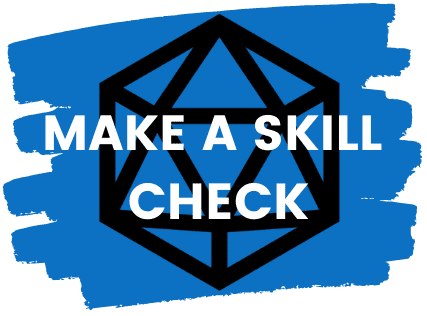On the go? Listen to the audio version of the article here:
It’s D&D night, and your party is exploring an unholy temple. Hiding up in the shadow-laden rafters, the fighter spotted a devilish assassin. He hurled a flask of holy water, drenching the enemy—but with no obvious effect. After it came to blows, the party discovered he was actually a Hobgoblin Iron Shadow—a goblin in a devil mask.
The difference here came down to the creature’s type, but what does that mean?
All creatures in D&D can be distinguished by their type, which indicates their fundamental nature. Certain abilities, items, class features, and spells interact with different creature types in unique ways. Some abilities don’t work at all unless aimed at a certain creature type.
For example, holy water only hurts fiends and undead creatures. The fighter had assumed too early that he was fighting one.
There are many distinguishing features of the various creature types. Let’s dive into what they are, classic examples of each, and some key class features that affect certain types.

Table of Contents
Creature Types A-Z
The fourteen creature types are:
- Aberrations
- Beasts
- Celestials
- Constructs
- Dragons
- Elementals
- Fey
- Fiends
- Giants
- Humanoids
- Monstrosities
- Oozes
- Plants
- Undead
Each has a unique nature and lore attached to it. These monsters can be found in the core published bestiaries: the Monster Manual (MM), Volo’s Guide to Monsters (VGM), and Mordenkainen’s’ Tome of Foes (MTF).
For more information, keep reading!
Aberrations
Aberrations are alien beings. They normally have an otherworldly feel to them, or they are literally otherworldly. Classic examples of aberrations are the many-eyed beholders and the Cthulhu-esque mind flayers.
While aberrations can be found in almost any place, many of them are found deep underground in the Underdark. Many of them are immune to being charmed, frightened, and being knocked prone.
Beasts
Beasts are natural animals that live on the material plane. They are a natural part of the ecology, although this does include more than what we have in our world. In D&D, there are also giant versions of animals and ones with magical and innate abilities that are still beasts.
You’ll want to know your beasts well if you’re a druid looking to use Wild Shape or a ranger wanting a beast companion.
Celestials
Celestials are beings that hail from the Upper Planes. There are relatively few published celestial creatures in the game. Examples include angels, pegasi, and the mighty empyrean. Aasimars are a playable race from VGM with celestial ancestry.
The paladin’s Divine Sense works on celestials and allows the paladin to know if there are any within 60 feet of them.
Constructs
Constructs are objects that have been given sentience by magical means. Examples include animated armor and any form of golem. Most constructs enact the will of their maker, who has either given them an ongoing command or continues to directly command them.
While many constructs cannot be tricked or persuaded, high-level constructs, such as a Helmed Horror, are intelligent beings that are capable of reasoning and changing tactics.
Golems are a classic example of constructs, and they can even be built by a PC who comes across a Manual of Golems (DMG, pg 180).
Dragons
Dragons are a staple of D&D. I mean, it’s in the name. The dragons that one could encounter in the game vary by age and by color.

According to the basic lore, chromatic dragons represent the evil side of dragonkind. If you want to slay evil, greedy dragons sitting on top of a pile of treasure, you’ll be hunting green, blue, black, red, and white dragons.
The metallic dragons represent the good side of dragonkind. Gold, silver, bronze, copper, and brass dragons will typically live peacefully in their lairs.
The older a dragon gets, the more powerful it grows. From youngest to eldest: wyrmlings, young dragons, adult dragons, and finally ancient dragons. Every dragon is immune to the damage type of their own breath weapon.
The dragon creature type also includes other draconic beings such as wyverns and dragon turtles.
Elementals
Elementals are beings native to any of the four elemental planes (excluding positive and negative energy planes). Beings made of fire, air, water, or earth are elemental creatures. Entire civilizations of elemental creatures live on these planes.
These civilizations include the four races of genies: dao, djinni, efreeti, and marid.
Fey
Fey creatures, despite their names, are not just creatures native to the feywild. Fey creatures include many mythical creatures primarily tied to the forces of nature. Examples include dryads and satyrs.
Archfey warlocks have made a pact with a powerful fey creature. Keep in mind that this could be a being from the Outer Planes as well,
Fiends
Fiends are beings native to the Lower Planes. There is a lot of lore dedicated to all the different fiends in D&D, boasting one of the largest lists of creatures of any type.
Underneath the banner of fiends are important subsets of monsters. Demons are chaotic beings spawned in the Abyss, devils are from the Nine Hells and live in a totalitarian society, and yugoloths are mercenary fiends that aren’t bound to the Nine Hells.
To dive further in-depth into the lore, I recommend you pick up the Dungeon Masters Guide (DMG, pg 57-67) and the Monster Manual (MM, pg 66).
Notable examples include the legendary prince of undeath Orcus, and the terrifying Demogorgon.

The paladin’s Divine Sense works on all types of fiends, and Divine Smite does an extra 1d8 damage against any fiend.
I’ll note that Night Hags are one of the few things with a weakness to silver (and magic).
Giants
Giants are towering humanoid creatures. Primarily, these are the six types of giant race: hill giants, stone giants, frost giants, fire giants, cloud giants, and storm giants.
In addition, monsters, such as trolls and ogres, are giant type creatures.
Humanoids
The word ‘humanoid’ describes this creature type well, as it is categorized by creatures that look similar to humans in their form and number of limbs.
This is not just limited to the human race, but also elves, dwarves, and halflings. Humanoids typically inhabit the majority of the material plane’s civilizations and culture.
Typically evil types of humanoids include orcs, kobolds, merfolk, kenku, tortles, and gnolls. A large subset of humanoids is goblinoid, which includes goblins, bugbears, and hobgoblins.
Rangers who have chosen two humanoid races for their Favored Enemy feature can choose from the above options.
Final Note: Lycanthropes (Were-creatures; e.g., werewolves) are generally considered humanoids, and they have a weakness to magic and silver (one of the few with this weakness).
Monstrosities
Monstrosities are monsters that the writers couldn’t put in any other category. It’s a bit of a catch-all for creatures that are just inherently monstrous but whose nature doesn’t fall into another category.
Some of these creatures are classic monsters from various folklore like krakens, mimics, and purple worms.
Oozes
Oozes are sentient creatures made from literal ooze. Oozes come in all kinds of viscosities, like stable gelatinous cubes, goopy jellies, and thick liquids. Typically found in dark, dank spaces, oozes wander around absorbing whatever life they come across.
Oozes are, for the most part, not intelligent beings and can’t be reasoned with.
Plants
The plant creature type is made up of sentient trees, plants, and moss. Even though mushrooms aren’t plants, fungi creatures are in this category as well.
The most well-known example of this type is the treant. Generally, plant-type creatures are immune to poison damage and to being poisoned, and many cannot be charmed.
Undead
Undead creatures are ghosts, skeletons, zombies, and other creatures that were once dead but, through some means, have regained a portion of life. Due to their nature, undead creatures don’t require air, food, drink, or sleep. Many of them are immune to being charmed, exhausted, poisoned, or paralyzed.
Some undead are incorporeal, while others have physical bodies they inhabit. If a being is incorporeal, you won’t be able to grapple, restrain, or knock them prone. This creature type is especially important for clerics and paladins. Some may only be harmed by spells or magical weapons, or else they may have resistance or immunity.
The cleric’s Turn Undead, and Destroy Undead, only work on monsters with this creature type. The paladin’s Divine Sense works with undead, and Divine Smite increases by 1d8 damage against an undead creature.
The final notable creature (mentioned here, at least) that is weak against silver and magic are Wraiths.
Summary
There are fourteen creature types in D&D 5e, and you can browse the options here. They are:

- Aberrations
- Beasts
- Celestials
- Constructs
- Dragons
- Elementals
- Fey
- Fiends
- Giants
- Humanoids
- Monstrosities
- Oozes
- Plants
- Undead
While each of them has unique qualities to them, things to note are:
- Druids can only use their Wildshape to turn into a beasts.
- Rangers’ companions must be beasts.
- Clerics can use Turn Undead and Destroy Undead on anything of the undead creature type.
- Paladins can use Divine Sense on celestials, fiends, and undead. Divine Smites deal an extra 1d8 damage to fiends and undead.
- Creature types such as constructs and oozes have very low to no intelligence and largely cannot be reasoned with.
There’s no hard and fast rule to different types being resistant or vulnerable to any particular kind of damage. If you’re into metagaming, you’ll have to start memorizing all of the damage resistances and immunities for individual monsters. Good luck!







0 Comments